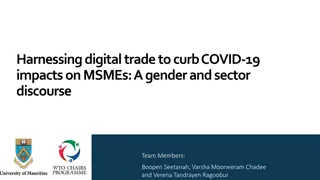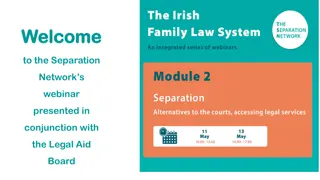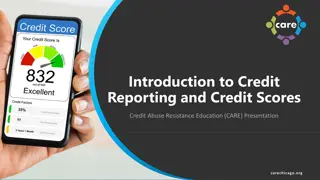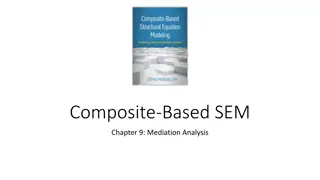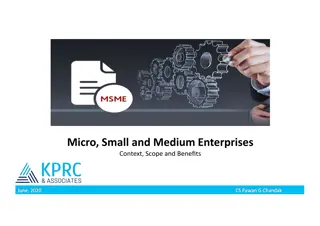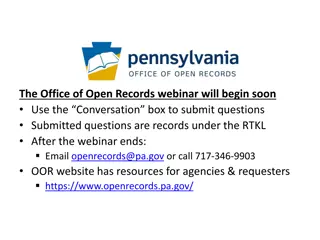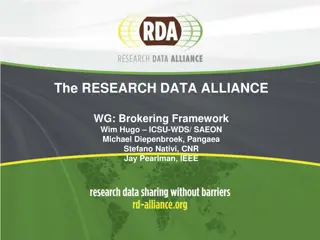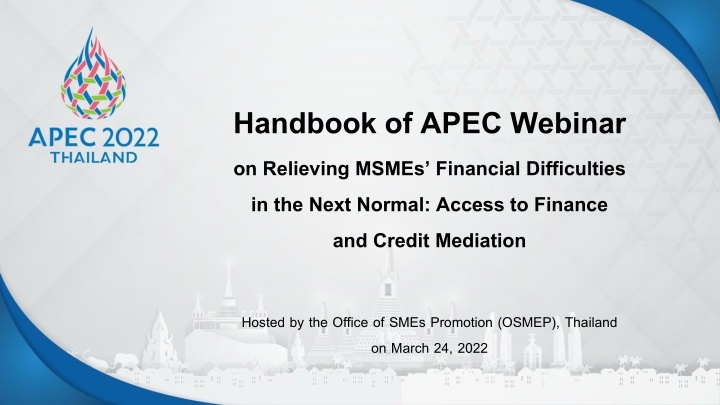
Relieving MSMEs Financial Difficulties in Next Normal: Access to Credit Mediation
Access insights from APEC webinar on MSMEs financial challenges and solutions, including credit mediation importance, success case studies, and policy recommendations to bridge the financing gap faced by MSMEs globally.
Download Presentation

Please find below an Image/Link to download the presentation.
The content on the website is provided AS IS for your information and personal use only. It may not be sold, licensed, or shared on other websites without obtaining consent from the author. If you encounter any issues during the download, it is possible that the publisher has removed the file from their server.
You are allowed to download the files provided on this website for personal or commercial use, subject to the condition that they are used lawfully. All files are the property of their respective owners.
The content on the website is provided AS IS for your information and personal use only. It may not be sold, licensed, or shared on other websites without obtaining consent from the author.
E N D
Presentation Transcript
Handbook of APEC Webinar on Relieving MSMEs Financial Difficulties in the Next Normal: Access to Finance and Credit Mediation Hosted by the Office of SMEs Promotion (OSMEP), Thailand on March 24, 2022
Agenda Background: pain point of MSMEs access to finance and credit mediation What is credit mediation? Case study: success case EU and APEC member economies Policy recommendations
Background: pain point of MSMEs access to finance and credit mediation 40% of MSMEs in developing economies have unmet demand for financing, and this demand gap is reported to be the highest in Asia-Pacific. MSMEs as informal businesses tend to have insufficient records to apply for formal credit, as well as have inadequate management experiences. These problems are structural in nature and not the consequences of COVID-19. Financial institutions wouldlikely find it risky to lend to MSMEs in view of their low value-added products and services, as well as small asset size. MSMEs lack of standardized fixed asset, especially liquid asset, exacerbates the risk profiles further. Furthermore, not all firms can access government support for financing. Smaller and younger firms tend to face greater challenges and receive less government support.
Agenda Background: pain point of MSMEs access to finance and credit mediation What is credit mediation? Case study: success case EU and APEC member economies Policy recommendations
What is credit mediation? Credit mediation schemesand credit review mechanisms are typically characterized by a mandate to facilitate information exchange between prospective lenders and borrowers, as well as to advise entrepreneurs on supporting services, monitoring of credit markets and reporting to competent authorities. Conduct independent assessments, submitted to the Financial Institutes (FIs) Facilitating communication between firms and the FIs Engaging professional networks and local institutions Informing the parties about guarantees and public support measures Why Credit mediation? To overcome information asymmetry between FIs and MSMEs Relatively low-cost interventions for governments: government bodies work as facilitators
Credit mediation process Source: OECD
Agenda Background: pain point of MSMEs access to finance and credit mediation What is credit mediation? Case study: success case EU and APEC member economies Policy recommendations
Case study: success case EU and APEC member economies The case of France and Ireland FRANCE 2008 The State, the Credit Mediator, the association of FIs 105 local mediators (Under Banque de France) IRELAND 2010 Credit review officer, the FIs Begin Ecology Capacity Panel of expert professional with front-line SME and farming enterprise finance experience Fee Free and confidential access Proportional to loan request (Max EUR 250) Average in 4 Weeks Response Time Mobilised loan (million EUR) Rapid 2,980 (2020) - Success Rate (percentage) 50.2 (2020) 54 (2020)
Case study: success case EU and APEC member economies The case of Indonesia Indonesia has successfully improved MSMEs access to finance by targeting accommodative regulations and incentives to the supply side. To enhance MSMEs financial capability, the member economy government has also launched several initiatives, including organizing financial institutions and business matching, developing financial application database or SIAPIK , and the introducing member economy standard QR code QRIS . The case of Canada Canada has facilitated MSMEs financial access through Canada Small Business Financing Program, which is a member economy government loss-sharing program in partnership with private lenders aiming to increase the availability of loans to small businesses.
Case study: success case EU and APEC member economies The case of New Zealand In New Zealand, the member economy government s support to the MSMEs during COVID-19 pandemic includessubsidy programs, tax reduction, and loan guarantee scheme. The member economy government has introduced a 50-billion-dollar COVID-19 response and recovery fund (CRRF) for MSMEs which covers - Business Finance Guarantee Scheme (BFGS)to support lending to viable businesses with the government taking up to 80% of the loan s default risk, allowing 4,000 SMEs to access credit for cashflow. - Small Business Cashflow Scheme (SBCS) to support small to medium-sized enterprises and organizations struggling with loss of revenue stream due to COVID-19. This scheme is open for applications until December 2023. - COVID-19 Wage Subsidy Scheme to ensure employers can continue to pay salaries and prevent job loss due to the pandemic.
Case study: success case EU and APEC member economies The case of Peru The member economy government has created financial business emergency program in order to help entrepreneur obtain resources while awaiting the activation of their commercial operations, especially in the form of credit guarantees. The case of Brunei Darussalam In Brunei Darussalam, commercial banks are operating the Co-Matching Grant Program to provide financing facilities to both large corporations and MSMEs. The program aims to provide a co-matching funding facilities for recipients to contribute 30%, with banks providing the remaining 70% of the loan outstanding.
Case study: success case EU and APEC member economies The case of China In China, the government institutions in charge of finance and industry has introduced Solution Trio projects for credit mediation, which include the following three campaigns. 1) ESG Mandate, in collaboration with the member economy government moderation, introduces key performance indicators (KPIs) for big enterprises and provide infrastructure support. 2) IT Support for MSMEs to make use of modern technology, such as IoT, big data, AI, blockchain, and edge computing. 3) Regulatory sandbox to supervise and regulate the use of new financial products and lending facilities. China makes use of fintech to facilitate credit mediation and provide post-loan management on the digital platform for financial institutions. For example, fintech could improve the financial institutions capability to support the industrial supply chain, reduce labor cost as part of the post-loan management and significantly reduce reliance of financial institutions risk capital by leveraging the digital platform.
Case study: success case EU and APEC member economies The case of Thailand: Thai Bankers Association Thai Bankers Association has initiated strategic plans focusing on four priorities that would be benefit for member economy and stakeholders; namely 1) Enabling member economy Competitiveness: open banking, utilities for common function, guideline and infrastructure and digital identity by improving through regulatory alignments with digital protection. 2) Regional Championing: cross border interoperability and central bank digital currency. 3) Sustainability: ESG theme such as Transition to BCG, dealing with household debt and financial inclusi n. 4) Human Capital: pool of talent upskill and reskill. Thai Banker Association have worked closely with the Bank of Thailand to introduce new regulations for MSMEs. Effective on March 7, 2022, they include soft loan facility for businesses, totaling 295 billion baht, to support 125,774 MSMEs affected by the COVID-19 pandemic and the Asset Warehousing project, totaling 40,700 million baht from 295 customers so far. These projects provide standardized debt restructuring program for adversely affected borrowers whose businesses require prolonged recovery period.
Case study: success case EU and APEC member economies The case of Thailand: the Ministry of Finance The Ministry of Finance has utilized financial institutions under the Thai credit Guarantee Corporation to provide credit guarantees to the MSMEs sector such as Portfolio Guarantee Scheme 9 (PGS 9) worth 150,000 million baht and theMicro Entrepreneurs 4 worth 25,000 billion baht. MSME Development strategies: 1) Helping MSMEs affected by the COVID-19 situation to retain their employees and create new jobs 2) Enhancing potential of MSMEs and building competitiveness to encourage rapid growth and 3) create the environment for facilitating the business sector to start and grow.
Case study: success case EU and APEC member economies The case of Thailand: Bank of Thailand Bank of Thailand and the member economy government launched a special loan program in the emergency decree aims to support commercial banks and specialized financial institutions to provide loan facilities to effected MSMEs, especially those with limited access to liquidity. The special loan was designed to reduce two major causes of COF lending; 1) cost of fund by giving a low rate borrowing by the BOT and 2) reduce the cost of default risk by providing a credit guarantee scheme through the Thai credit guarantee corporation. Program 1: Long term debt restructuring measures program aims to encourage financial institutions to tailor debt restructuring to match with debtor problems with revenue reducing drastically from the COVID-19. What is to be done is a debt restructuring that match with debtor s problems and debt repayment ability. This will reduce the shock and help corporates to adapt to a new position. Program 2:
Case study: success case EU and APEC member economies The case of Thailand: Bank of Thailand The doctor debt by a collaboration of Bank of Thailand and the Thai credit guarantee corporation to provide advice to MSMEs such as how to adapt business strategies in the uncertain world and how to prepare themselves to negotiate with banks either for debt restructuring or new loan applications. Program 3: Bank of Thailand published a consultation paper to layout the important directions and policies to repositioning the Thai financial sector in a new landscape. The landscape in which BOT needs to ensure financial stability but also recognizing the importance of technological advancement and environment changes. Program 4: Proposal on financial landscape paper is an introduction of general credit guarantee facility (GCGF). The GCGF aims to provide better access to funding source for businesses, especially for MSMEs. The design will accommodate different stages in their businesses cycle. From loan in banks, funding for start-ups, or support for MSMEs to enter capital markets. Program 5:
Agenda Background: pain point of MSMEs access to finance and credit mediation What is credit mediation? Case study: success case EU and APEC member economies Policy recommendations
Policy recommendations Capacity building Digital transformation, accelerated by the pandemic, has created new Fintech and online lending, can provide alternative sources of finance for MSMEs. MSMEs should make use of digitization to standardize asset quality in line with the requirements of financial institutions. In a longer term, MSMEs should focus on improving credit quality as seen in productivity, competitiveness, and globalization. The ecosystem of MSMEs access to finance can be done through knowledge sharing and capacity building, which all APEC economies can work together to achieve.
Policy recommendations Government recognition and support Member Economy government should also consider improving traditional lending s constraints by introducing credit guarantee scheme, promoting financial literacy among MSME entrepreneurs, as well as addressing informality. In order to expand the financial options available to MSMEs, member economy governments should continue to consider the more traditional path of MSMEs funding while also attending to new developing in the sector. For the short to medium term, the member economy government s MSMEs policy should focus on tackling the issues of finance/liquidity, market access, missing middle and competition. The member economy government policy should focus instead on developing MSMEs capacity to pay by improving their fundamentals. This could be implemented by providing research and training to support products value-adding.
Policy recommendations Government recognition and support In the longer term, the member economy government can help build the ecosystem for MSMEs by promoting information-based lending, using Big Data technology to support lending decisions, together with other policy upgrades, such as developing secured transaction law, designing credit guarantee schemes, and fostering credit information sharing. It is also critical to support the environment for FinTech development and efforts to bridge the widening credit gap that entrepreneurs have encountered during the COVID-19 pandemic. The member economy government may also provide new funding opportunities and financial support schemes in order to reach small business owners. The member economy government should also focus on supporting the recovery and resilience of MSMEs and entrepreneurs aiming to control over-indebtedness and solvency, as well as ease MSME liquidity constraints.
Policy recommendations Government recognition and support To promote the adoption of digital technology by owners and employees of small firms, the member economy government may provide tax incentives or loans for training and new technology adoption. APEC support APEC can facilitate collaboration between MSMEs from a developed member economy with a lower- income member economy for the transfers of technologies and techniques to further develop their products and services and go global. Regional integration, connectivity, digitalization, inclusiveness and sustainability are among key agenda priorities for both private and public sectors in most of regional corporations including APEC.





